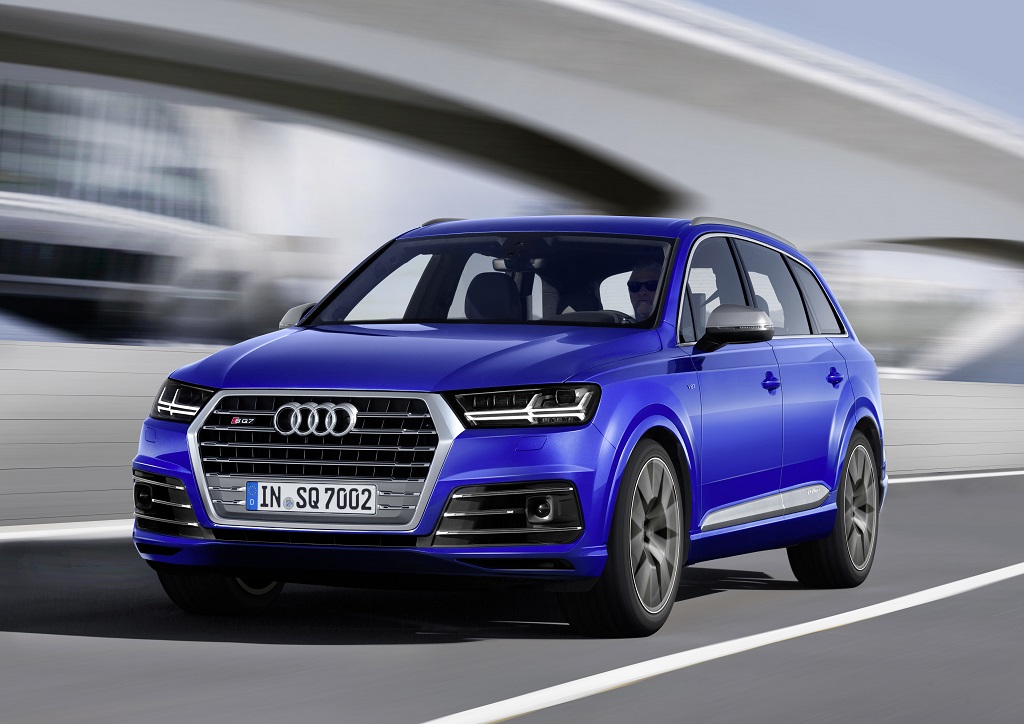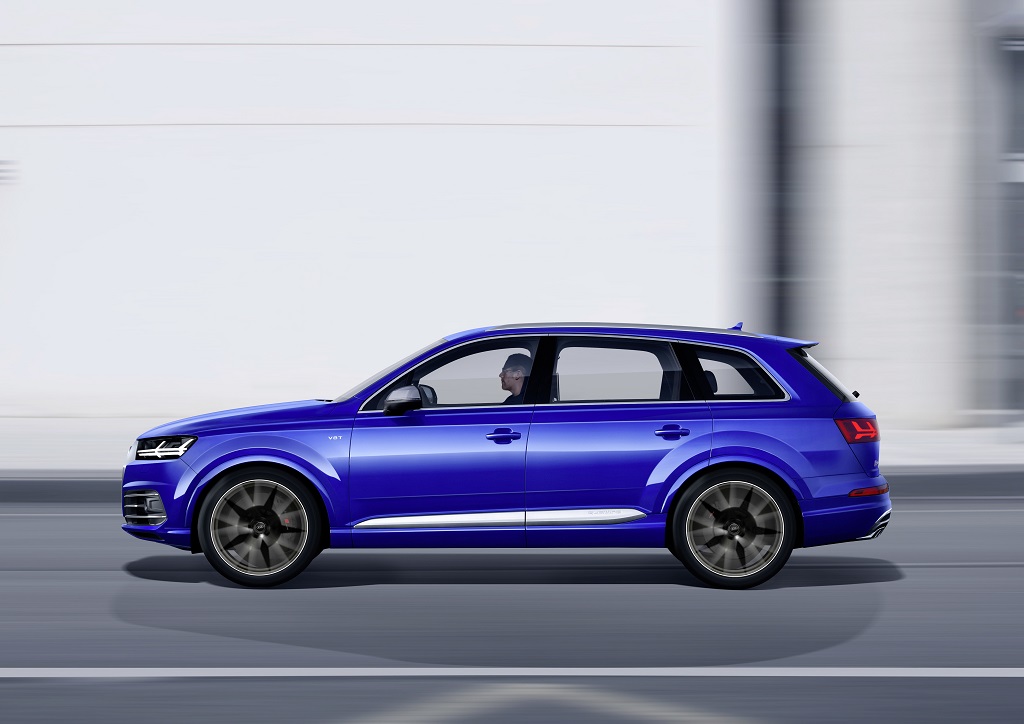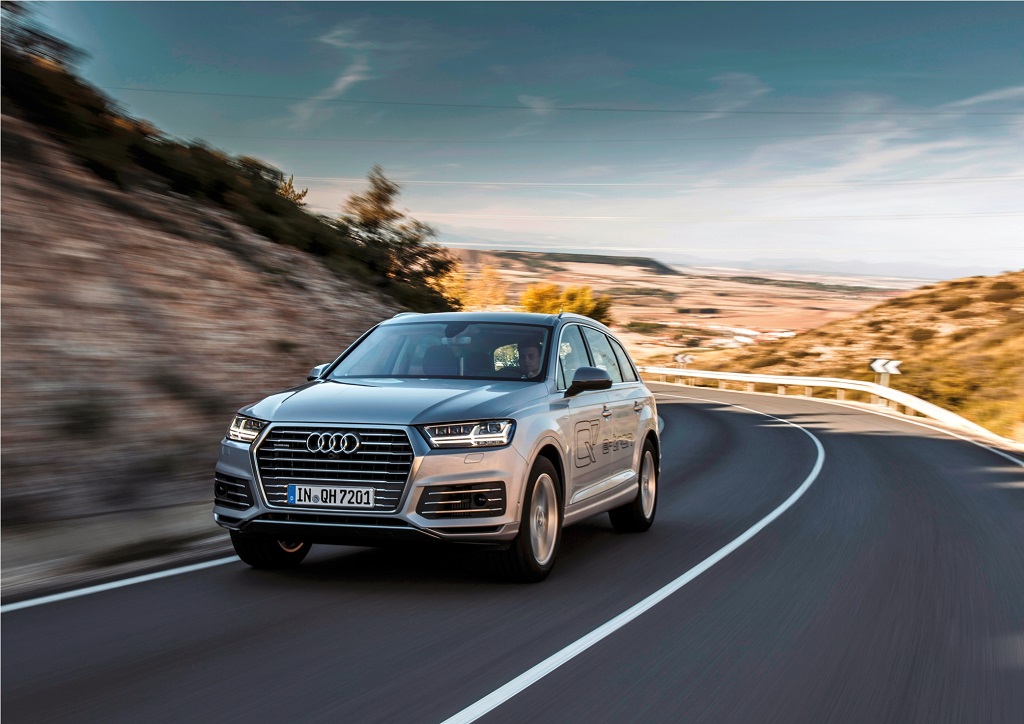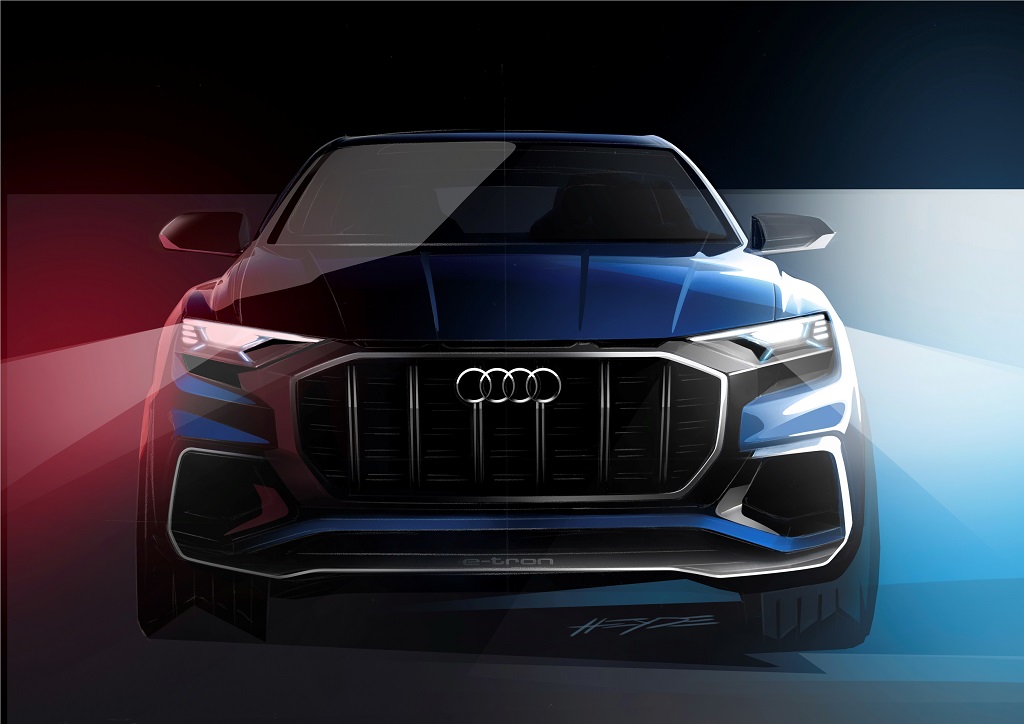- First S model in the Audi Q7 model line
- World first: electric powered compressor
- Also new at Audi: high-performance, 48-volt electrical subsystem and electromechanical active roll stabilization
With 320 kW (435 hp) and 900 Nm (663.8 lb ft) of torque, the new Audi SQ7 TDI* is the most powerful diesel SUV on the market. It also leads the competition in numerous other technical fields. Its newly developed 4.0 TDI engine features a world first: An electric powered compressor gives the SQ7 TDI outstanding off-the-line performance. Yet it consumes on average 7.4 liters of fuel per 100 kilometers (31.8 US mpg).
“Following the launch of the successful SQ5*, we are now also applying the concept of a dieselengined S model to the Q7 model line. So equipped, the SQ7 TDI with a V8 TDI engine achieves the consumption figures of a six-cylinder. The new technology solution of the electric powered compressor in the SQ7 TDI is a world first in the competitive environment, with which Audi once again underscores its claim Vorsprung durch Technik,” said Dr. Stefan Knirsch, Member of the Board of Management of AUDI AG for Technical Development.
Forced induction: Three chargers working together
The 4.0 TDI has been newly developed from the ground up. It combines best-in-class performance with low consumption and guarantees maximum dynamics. The V8 engine has a displacement of 3,956 cc. The two exhaust-gas turbochargers are activated selectively according to the concept of sequential charging, since exhaust gas only flows through one turbocharger at low and intermediate load. The second turbine is only activated at higher loads. An electric powered compressor (EPC) augments the work of the two turbochargers, particularly in the lower engine speed range, providing for extremely dynamic off-the-line performance.
With 320 kW (435 hp) and 900 Nm (663.8 lb‑ft) of torque between 1,000 and 3,250 revolutions per minute, the SUV sets new benchmarks in the segment. It accelerates from 0 to 100 km/h (62.1 mph) in 4.8 seconds; top speed is 250 km/h (155.3 mph) (governed). In the New European Driving Cycle (NEDC), it consumes 7.4 liters per 100 kilometers (31.8 US mpg). This corresponds to CO2 emissions of 194 grams per kilometer (312.2 g/mi).
Forced induction concept and electrical system: Electric powered compressor (EPC) and 48‑volt subsystem
The electric powered compressor is a world first in a production vehicle. This EPC strongly supports the 4.0 TDI engine when starting off and accelerating from low load for pure dynamics with no turbo lag. It is placed in the air path downstream of the intercooler, close to the engine. Because the EPC does not require any exhaust-gas energy to develop boost, it can be used at any time, thus making it the solution for the traditional weaknesses of the classic exhaust-gas turbocharger. With this technology, turbo lag is history. The EPC provides the engine the boost energy needed for the dynamic delivery of power in less than 250 milliseconds. Driven by a compact electric motor, its compressor wheel spins up to 70,000 revolutions per minute. The 4.0 TDI thus develops its immense power with no perceptible lag: It is available immediately upon depressing the accelerator. That is a major plus, particularly when starting off.
The Audi valvelift system (AVS) is also making its debut in a diesel model from Audi. The inlet and exhaust cam shafts each have two cam contours per valve. On the inlet side, one cam contour supports starting off in conjunction with the EPC, while the other optimizes cylinder filling and thus power at high engine speeds. The AVS system on the exhaust side enables activation of the second exhaust-gas turbocharger. The sequential charging system controls the two exhaust-gas turbochargers so that only one turbocharger is used at low engine speeds. The second is activated additionally at higher loads and engine speeds. The customer benefits from very good torque delivery and dynamic response across the entire engine speed range.
The exhaust streams from the two exhaust valves are hermetically separated, with each driving one of the two turbochargers. In the lower engine speed range, one valve per cylinder remains closed, so that the full exhaust stream flows to the active turbocharger. When load and engine speed increase, the AVS opens the second exhaust valves. This directs flow to and activates the second exhaust-gas turbocharger. The engine achieves its maximum output in this biturbo mode. The switching by the AVS enables fast and precise activation of the second exhaust-gas turbine.
The power for the EPC, which reaches a maximum of 7 kW, is provided by the 48‑volt electrical subsystem. The SQ7 TDI uses this higher-power electrical system, which facilitates the high-power systems electromechanical active roll stabilization (EAWS) and EPC. To meet their high power and energy requirements, the electrical subsystem includes its own 48‑volt lithium-ion battery mounted beneath the luggage compartment with a nominal energy content of 470 watt-hours and peak output of up to 13 kilowatts. A DC/DC converter connects the 48‑volt and 12‑volt electrical systems. The required energy is provided by a more powerful and highly efficient generator with an efficiency of over 80 percent at an output of up to 3 kW. This is a so-called MOSFET generator (Metal Oxide Semiconductor Field Effect Transistor), which reduces electric losses and increases efficiency. MOFSETs replace the diodes used previously. In addition, the 48‑volt storage unit supports the 12‑volt electrical system when required. This also reduces the load on the 12‑volt lead battery.
V8 TDI – further technical highlights
The intake side of the 4.0 TDI is on the outside, the exhaust side with the two turbochargers is on the inside of the 90-degree internal V. This layout provides for short gas paths, i.e. spontaneous response and short paths for the emissions control system. The common-rail system generates up to 2,500 bars of injection pressure. Ignition pressure reaches the 200‑bar mark in broad sections of the characteristic.
The innovative thermal management and sophisticated measures in the crankshaft and camshaft drive reduce friction. With the combination of a NOx oxidating catalytic converter and a downstream SCR catalytic converter, which is integrated into the diesel particulate filter and uses AdBlue injection to reduce oxides of nitrogen, the V8 TDI has a particularly efficient emissions control system. A sound actuator in the exhaust system amplifies the sonorous eight-cylinder sound. SQ7 TDI drivers can choose how much attention they want to draw to themselves by using the Audi drive select system to vary the amount of sound.
The biturbo V8 combined with the EPC is a core element of the global Audi diesel strategy. With high torque even at low engine speeds and low consumption figures, it is also ideally suited for markets such as the United States. Its engine characteristic combines supreme pulling power with sporty agility – ample off-the-line performance and spontaneous response.
High efficiency: The eight-speed tiptronic
The 4.0 TDI in the Audi SQ7 TDI works with strong partners. The proof is in the road behavior, from extremely comfortable cruising on the Autobahn to dynamic handling on mountain passes. The redesigned eight-speed tiptronic is impressively efficient. It changes gears extremely quickly and efficiently, and at high speeds allows
coasting at idle. A self-locking center differential is the heart of the quattro permanent all-wheel drive system. It is compact, lightweight and interacts very precisely with the suspension control system.
The maxim of lightweight construction also applies to the suspension – its links are made primarily of aluminum. Electromechanical power steering, the Audi drive select driving dynamics system and adaptive air suspension with S-specific tuning are standard. An optional brake system with extremely lightweight carbon fiber-ceramic disks will follow shortly after the market launch. Audi offers the SUV with 20‑inch wheels on 285/45 tires, with options up to 22 inches from the quattro GmbH program.
Networked suspension control
Audi offers the SQ7 TDI with an optional driving dynamics package comprising three technology modules: sport differential, electromechanical active roll stabilization and all-wheel steering. The highly integrated suspension control unit is used in the SQ7 TDI. It assumes the central control of the adjustable shock absorbers, the air springs, the sport differential and roll force distribution. By bundling all relevant suspension functions into a central control unit, the developers achieved an optimal networking and coordination of the functions among themselves. The customer thus experiences outstanding handling in any situation. Sporty or comfortable: Body roll stabilization
A new solution in the competitive environment is the electromechanical active body roll stabilization. Here a compact electric motor with a three-stage planetary gearbox separates the two halves of the stabilizer. On an uneven road surface, they are actively decoupled from one another, resulting in improved ride comfort. During sporty driving, the tubes are interconnected and twisted against each other. That significantly reduces body roll, i.e. the lean of the car. Together with the transmission, the electric motors produce anything up to 1,200 Nm (885.1 lb‑ft) of torque. The effect is taut, sporty handling: The car leans less in bends and the tendency to understeer is further reduced.
The front and rear stabilizer can be adjusted independently of each other. This active distribution of stabilizer forces between the front and rear axle has a positive effect on road behavior. Steering precision and the agility of the car improve significantly.
Compared with conventional hydraulically switched stabilizers, the 48‑volt-based system from Audi offers major advantages. It can develop more power, it works faster and it is activated even at low speeds. Because it requires no oil, the electromechanical active roll stabilization is also maintenance-free and environmentally friendly.
Bold road behavior and handling: All-wheel steering in combination with sporty and direct front-axle steering With all-wheel steering, the rear wheels turn in by as much as five degrees, making parking easier. The more direct front-axle steering ratio of the SQ7 TDI improves the handling characteristics. Depending on the situation, the rear wheels steer opposite or in the same direction as the front wheels, improving dynamics and stability.
High agility in every curve: quattro with sport differential
For sporty drivers, it is one of the central objectives of road behavior: neutral handling up to the limit, even at high engine power. The optional sport differential provides stable and precise steering, particularly when accelerating dynamically out of curves. Variable torque between the wheels on the rear axle offers supreme control in curves. The SQ7 TDI is pressed precisely into the curve as a result. Even if the rear end starts to swing out, the quattro sport differential brings it back under control. This technology is available for the first time in the Q7 model line and is reserved exclusively for this top model.
Lightweight construction – innovative multimaterial construction
Thanks to systematic lightweight construction, the Audi SQ7 TDI is the lightest SUV in its segment, yet makes no compromises with respect to crash safety. The body features an innovative multimaterial construction. Hotshaped and extremely strong sheets form the backbone of the occupant cell; the outer skin is made of aluminum. The center of mass is low – another factor for the sporty handling. The drag coefficient is an outstanding 0.34.
Powerful sportiness: Exterior styling
The new Audi SQ7 TDI strikes an impressive balance between powerful and intensified stylistic elements. At 5.07 meters (16.6 ft), it is approximately as long as the base model. The Audi DNA, such as the sculpted Singleframe radiator grille, distinctively highlighted wheels and flared quattro-style blisters, is unmistakable.
All lines and surfaces are designed precisely and incisively, and accentuate the width of the car and thus the solidness of the overall concept. The SQ7 TDI has a new radiator grille with an S‑specific design at the bumpers. Other distinguishing features are the side air inlets, the mirror housings and door inlays in standard aluminum. The exhaust system terminates in four rectangular tailpipes.
Light – LED headlights standard
The headlights have a pronounced three-dimensional appearance overall with a double-arrow signature. The standard LED and optional Matrix LED headlights plus the dynamic rear turn signals underscore Audi’s leading role in lighting design and technology. With the LED and matrix LED headlights, the daytime running lights together with the turn signals form a double light guide arrow – a new and unique light signature within the Audi family. Each Matrix LED headlight divides its high beam into 30 individual light-emitting diodes paired with three reflectors. A camera on the interior mirror analyzes the traffic situation. Given this information, the control unit individually turns the diodes on and off, or dims them in 64 stages each, depending on the situation. With the millions of different resultant beam patterns, the high-end headlights superbly light up the road, without blinding other road users. Traffic signs are illuminated with less power so that the driver is not blinded by glare.
The functional range of the Matrix LED headlights also includes intelligent cornering lights, created by a shift in the light center position. If the car is equipped with the optional MMI navigation plus, this system’s route data will trigger the cornering light to illuminate around the corner just before the driver begins turning the steering wheel. The large LED rear lights vary the theme of the headlamps: The tail lights, activated when the ignition is turned on, create a double arrow like the headlights. The brake light is located in the two upper chambers; the interior of the light has a three-dimensional appearance, with lightness and elegance.
The choice is yours: five seats or seven
Passengers in the Audi SQ7 TDI experience the largest interior in the segment. Audi offers the SUV with a choice of either five or seven seats. The second row comes standard with a three-section backrest with segments that can be folded down separately. The optional third row folds up and down electrically.
Interior quality with S-specific design language
More space in the interior sets a new benchmark in the segment. Diffuser vent wrap and application strips emphasize the horizontality and spaciousness of the interior. Comfort features are luxury-class. With the SQ7 TDI, customers have the choice between sport seats and sport seats plus. The sliding/folding seats provide for easier access to the optional third row. The power tailgate is standard. The SQ7 TDI boasts elegant design solutions in the interior, including analogue instruments with gray faces and white needles, special welcome screens and S badges.
The complete interior lighting including the luggage compartment employs LEDs. The first upgrade level, the lighting package, is standard. Capacitive (contactless) switches control the light in the door pockets and the reading lamp. The instrument panel and door trim contain so-called contour lighting – extremely slender LED light guides that follow the broad lines. Ambient lighting is also available. This includes lighted door sill trims and additional contour lighting on the center console. The top version allows the driver of the SQ7 TDI to customize the interior lighting. Via the MMI, the driver can adjust it in several profiles and in five zones, and regulate the color of the contour lighting in the “drive select” profile in 32 steps.
Markedly sporty: exclusive materials, colors and equipment features
The new SQ7 TDI is available in 12 colors. The distinctive radiator grille and underbody guard that encloses the four rectangular tailpipes are finished in twilight gray matt. Thanks to a wide range of equipment, the SQ7 TDI can be configured to be both sporty and elegant. Two-piece applications enable diverse material combinations and further individualization. The SQ7 TDI is also available with the design selection Kodiak brown: a fullleather interior with contrasting stitching, an Alcantara black headlining, sport seats plus with Valcona leather in Kodiak brown and contrasting stitching, and luxury velour floor mats. The two-piece trim strip of Sono aluminum and carbon twill copper is exclusively available for the SQ7 TDI.
High-resolution graphics: Audi virtual cockpit
With its 12.3‑inch display, the optional Audi virtual cockpit presents logically structured information in brilliant graphics. Driver ergonomics are excellent, and operation is intuitive. The driver chooses the display mode via the multifunction steering wheel. A head-up display is also available as an option.
The optional MMI navigation plus with MMI all‑in‑touch includes a large glass surface on the center tunnel console that provides the finger with haptic feedback after each click. The MMI logic allows for intuitive system operation and also understands terms from everyday speech.
Potent computing power: Infotainment and Audi connect
MMI navigation plus, the optional top-of-the-line infotainment system in the SQ7 TDI, uses the second generation Modular Infotainment Platform. Thanks to the integrated LTE module and the Wi-Fi hotspot included in the Audi connect package, passengers can surf at high speed with their mobile devices. The Audi connect package brings comprehensive online functions on board.
New on the market is the Audi connect safety & service package, which also includes the myCarManager package. With this, customers can use their smartphone to lock and unlock the car or check the vehicle status, for example.
Another infotainment highlight is the Audi smartphone interface. In the car, a tailored environment on the MMI monitor makes it easy to control smartphones with iOS or the Android operating system.
The sound systems in the SQ7 TDI are as innovative as they are upscale. In the Bang & Olufsen Advanced Sound System, the digital signal processor drives 11 channels with a total of 23 speakers in such a way that the sound is equally precise and harmonious in every seat. Four speakers installed in the A‑pillars and driven via separate channels broadcast those elements that generate the spatial height, creating a big virtual stage. Newly developed speakers and an amplifier with 1,920 watts guarantee musical enjoyment at the highest level. The Bose Surround Sound system, which generates the surround sound with 19 speakers, also features two speakers located higher up in the A‑pillars to produce the third dimension.
Optionally, two Audi tablets can be docked in the backs of the front seats. This solution is currently the only removable rear seat entertainment system available in the segment as standard. The Audi tablets make the premium infotainment accessible to the rear passengers as well. With integrated entertainment media and the navigation system from the infotainment system, the Audi tablets bring the full functionality of current high-end Android tablets to the car.
Simply the best: Driver assistance systems
The SQ7 TDI offers a wide range of 24 driver assistance systems to help drivers travel safely, fuel-efficiently and comfortably. The predictive efficiency assistant, for example, provides additional information in the instrument cluster to help the driver save fuel. The standard Audi pre sense city – an anticipatory warning and emergency breaking function for avoiding accidents and protecting pedestrians – makes the SQ7 TDI even safer.
The adaptive cruise control with traffic jam assist relieves the driver in slow-moving traffic on well-paved roads by taking over the steering in many situations. The predictive ACC enables the anticipatory adjustment of driving speed to the route and speed limits, such as when entering towns.
In Europe, the Audi SQ7 TDI can be ordered beginning spring 2016. It will be offered in Germany for a base price of €89,900. This price includes a significantly expanded range of standard equipment, valued at approx. €10,000, compared with the base model. Examples include LED headlights, 20-inch wheels, sportily contoured bumpers and door trim strips, adaptive air suspension with S-specific tuning, electrically adjustable and heated sport seats in Alcantara and leather, brushed aluminum inlays, 3-spoke multifunction sport steering wheel with shift paddles, anti-theft alarm and an enlarged tank with 85-liter capacity. In addition, the Audi SQ7 TDI is also the first production vehicle to feature an electric powered compressor with a 48-volt electrical subsystem. The factory-installed sound exhaust system provides for a sporty, unmistakeable V8 sound.





